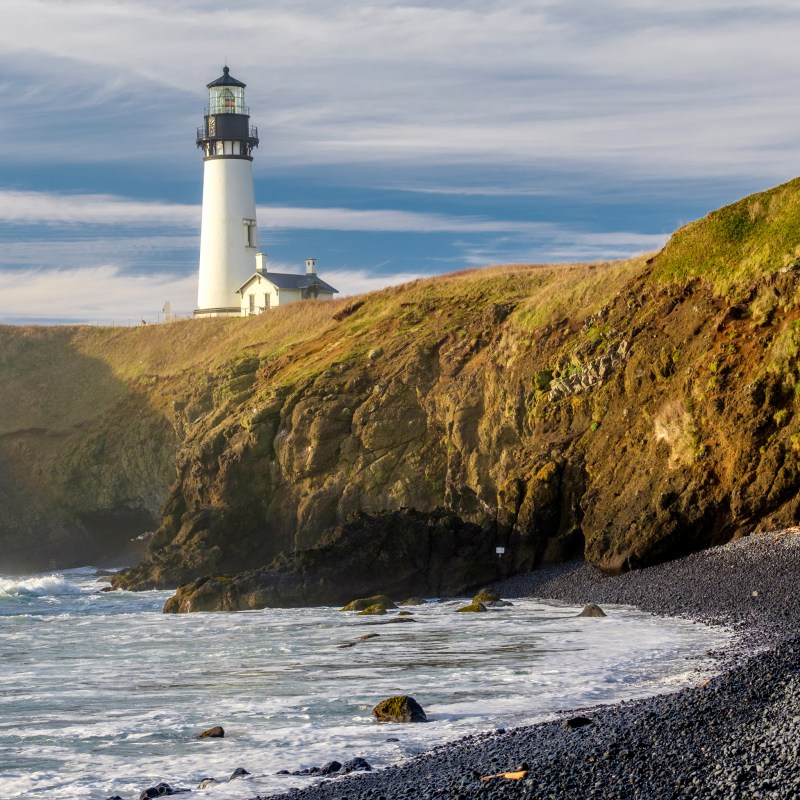
Sea stacks and jagged reefs, capes protruding into the ocean featuring sandstone cliffs, and shifting sand dunes make the Oregon coast the stunning shoreline we love. However, these same landscape features present threats to ships getting close to the shore. Lighthouses helped their captains navigate these dangers, guiding them to safety.
Videos by TravelAwaits
The earliest lighthouses had one white light warning seafarers that a shore was close. Visible about eight miles at sea, it didn’t always allow enough time to bring the ships to safety. Introducing the Fresnel lens in the mid-1800s brought a dramatic improvement. The elaborate system of lenses extended the light’s visibility to around 20 miles and allowed it to form individual patterns. With this innovation, the lighthouses could each have a signature pattern. Now they acted like navigation systems, signaling ship captains their location on the shore.
No longer needed for navigation, historic lighthouses now stand as witnesses of a past era. Automated, with no need for keepers, a few are still operating, and seafarers rely on them as backup navigation systems.
Seven of the original lighthouses of the Oregon coast are open to the public. If you time your visit right, you can tour them to learn about their history and understand the way they work.

1. Cape Meares Lighthouse
The northernmost Oregon lighthouse open to visitors, the Cape Meares Lighthouse is the shortest on the coast. Though only 38 feet high, the lighthouse stands 217 feet above the ocean on the edge of the cape. When built, this lighthouse was so isolated, it didn’t even have a wagon road leading to it. All building materials, including the large Fresnel lens, which weighed over a ton, were brought on a ship and pulled up on the high cliff using a hand-operated crane built from spruce trees found on the cape.
The Cape Meares Lighthouse started operating on January 1, 1890. The keeper used a kerosene lamp, later replaced by oil, inside the lens to flash its signature combination of white and red light.
Though decommissioned in 1963, the lighthouse still stands as part of the Cape Meares State Scenic Viewpoint and is open for tours between April and November. You can visit it as a stop on the Three Capes Scenic Route.

2. Yaquina Head Lighthouse
After seeing the shortest lighthouse on our list, you’ll reach the tallest as you make your way south on the Oregon coast. Standing 93 feet tall at 162 feet above sea level, the Yaquina Head Lighthouse, on the tip of a narrow strip of land, is still active and working, its light visible for 19 miles offshore. Built in 1873, it uses its original lens, though the light is automated now, flashing its signature pattern all day long.
You can take a guided tour of the lighthouse and even climb the spiral stairway to the top. With 114 stairs, it is a long way to climb, but if you do, you’ll have gorgeous views, and you might spot a few migrating grey whales. However, you can have a great experience touring the surroundings and the lower room of the lighthouse even if you opt not to climb to the top.
You’ll find this lighthouse in the Yaquina Head Outstanding Natural Area. While there, explore the tide pools and watch seals and migrating sea birds on the rocks.
The road leading to the state park and lighthouse is off Highway 101, just three miles north of Newport.

3. Yaquina Bay Lighthouse
The Yaquina Bay Lighthouse is at the southern end of Newport, at the mouth of the Yaquina River. It doesn’t look like a traditional lighthouse, though; in fact, it resembles more of a two-story house with a tower attached to it. The only historic wooden lighthouse on the coast still standing, and the only one with the living quarters attached, it was built in 1871 and decommissioned in 1874, serving the shortest time as a lighthouse.
Restored and relit in 1996, the Yaquina Bay Lighthouse is a working lighthouse, with a steady white light shining from dusk to dawn, and is open for visitors as a museum.
To reach it, turn right off Highway 101 and follow signs for the Yaquina Bay Recreation Site.

4. Heceta Head Lighthouse
The Heceta Head Lighthouse is the most photographed and most visited lighthouse on the Oregon coast. Still active, its automated signature beacon is visible for 21 miles.
Built in 1894, the 56-foot lighthouse stands on Heceta Head, one of the most scenic areas of the Oregon coast. Though its location is the primary reason for its popularity, the lighthouse has another claim to fame as one of the most haunted lighthouses in America. Its ghost, known as the Grey Lady, was the wife of a keeper from the 1890s.
You can take a tour of the outdoor area and the ground floor of the tower. Upper levels are closed for visitors, but a short trail takes you to a viewpoint of the lens.
The original keeper’s house, which is still standing, is a bed and breakfast where you can spend a night. The current innkeepers also offer tours of the first floor of the keeper’s house by appointment, which can be made by calling (866) 547-3696. The bed and breakfast is near Heceta Head Lighthouse Scenic Viewpoint. Note that there’s a half-mile-long trail through the forest between the viewpoint and the bed and breakfast, but though it’s short, it is relatively steep, with an elevation gain of 150 feet. Luckily, the bed and breakfast has its own private driveway and parking lot for overnight guests, so you don’t have to make the hike unless you choose to. If possible, since you’ll be at one of the best spots for whale watching, give yourself more time in the area.
Editor’s Note: For more whale-watching inspiration, consider these seven tips for whale watching along the Oregon coast.

5. Umpqua River Lighthouse
The Umpqua River Lighthouse was the first one built on the Oregon coast, though you cannot see the same structure today. Shifting sands caused the original to collapse only four years after it was built. Signaling the entrance to the Umpqua River, the one still standing replaced it in 1894. Still operating, it shines its alternating white and red beams.
Part of Umpqua Lighthouse State Park, the lighthouse itself is relatively quiet, though it is surrounded by the Oregon Sand Dunes and overlooks a busy day-use and camping area, which are often teeming with people. You’ll find the lighthouse if you follow the Umpqua Lighthouse Loop outside of Winchester Bay, off Highway 101.

6. Coquille River Lighthouse
The Coquille River Lighthouse, built in 1896, originally stood on a rocky islet reached by a footbridge. Time has changed the landscape, and now the north jetty is connected to the land where the lighthouse stands.
Featuring a 40-foot-tall cylindrical tower connected to an elongated, octagonal room with a fog signal, the lighthouse was active until 1939. Then it sat abandoned until the late 1970s, when it was renovated and opened up to the public as an interpretive center. Claimed as a symbol of nearby Bandon, it is also referred to as the Bandon Light and is open for visitors from May to October.
Part of Bullards Beach State Park, you’ll find it about two miles north of Bandon.

7. Cape Blanco Lighthouse
The southernmost lighthouse on this tour, the Cape Blanco Lighthouse, with its 59-foot tower, stands 245 feet above the water. Built in 1870, it is the oldest continuously operating light on the Oregon coast, with the highest focal plane above the sea. Jutting out one-and-a-half-miles into the sea, it sits on the westernmost tip of the coast. It is also the lighthouse that had the first woman keeper.
Away from the main tourist sites of the Oregon coast, at the end of a five-mile road off Highway 101, this lighthouse promises a quieter, more contemplative experience.
Part of Cape Blanco State Park, the lighthouse offers guided tours from April to October. You can also tour the historic Hughes House dating from 1989, and hike down to the beach to play in the sand.
Pro Tips
You can reach all these lighthouses during one long road trip down the Oregon Coast Highway 101. Considering the distance between the northernmost Cape Meares and southernmost Cape Blanco is 225 miles, it would be best to take a few days for it and experience other attractions on the coast along the way.
Check the websites to make sure the lighthouses are open when you plan to visit and plan your visit between May and October for the best chance to catch them open. But don’t be disappointed if you find them closed. They are worth a stop, even if you only see them from the outside. Besides the views, their surroundings are perfect for whale watching, beachcombing, hiking, and wildlife viewing. For more Oregon coast inspiration, also read up on how to safely observe coastal Oregon’s King Tides.
